| Terrahawks - Behind The Scenes Special |
| Terrahawks - Behind The Scenes Special |
| Zelda's Space Fleet |
| The
television series Terrahawks began with an alien space
fleet attacking a NASA installation on Mars, and then
landing to claim the planet for themselves in order to
launch attacks against the planet Earth. This fleet consisted of seven vessels that could interlock to form one giant structure, which was controlled from the central spider-like Hub by the evil queen Zelda. According to publicity information the six other spaceships were called - Fin, Dog, Shark, Rhino, Ice-Box, and Phantom |
| Fin took centre stage in the
first episode as it has the ability to alter its size,
and has an invisible force field. Dog is a space cruiser with very heavy power capacity. Shark has underwater capability, and contains many other smaller craft. Rhino is able to transport many vehicles to other planets and launch numerous ZEAFs. Ice-Box is Zelda's laboratory, and contains the cryogenic chamber that is full of alien monsters. Phantom is a metamorph vehicle, able to change shape into different ridged structures. |
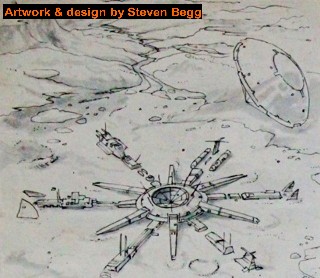 |
| This all sounds
very interesting but sadly the people who actually built
the models, and the SFX director who shot them, weren't
actually told about any of it - so this is possibly just
complete invention by the publicity department! This means that we really aren't sure which vehicle is which, unless someone has a special guide to hand? |
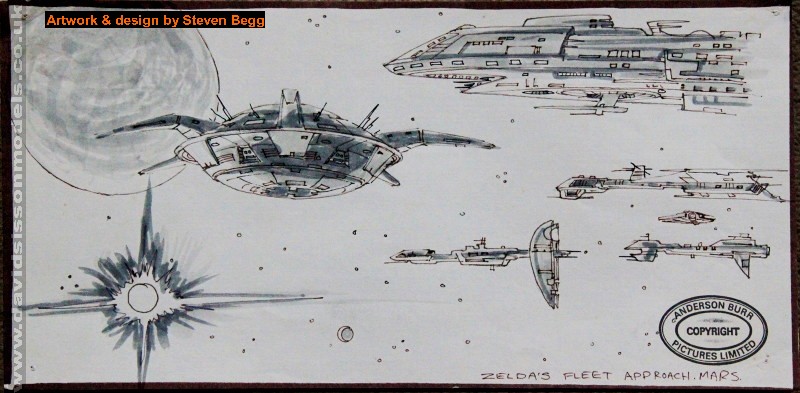 |
| Above: Two of Steven Begg's initial design drawings for the alien fleet. |
| Steven Begg: I absolutely don't know their names, as I believe that it was all invented by Gus Ramsden who was Ian Scoones assistant at the time. I'd concocted the initial designs, but they were superseded by Gus, John Lee and Steven Woodcock's ideas, which was fair enough.... I think they possibly thought of some sort of Transformers type stuff for the ships which we never realized. |
 |
| Above: One of the surviving effects models, slightly restored as some of the side fins were missing. 29" length. Courtesy Bob Bailey |
| Steven
Woodcock: Zelda's ships weren't named when John
and I were involved, apart from the Dog and Rhino. The
name Dog was a workshop nickname that we gave it, and
that was one of the models that I made. The Rhino was one
of John's, and I believe that it was the only one ever
named in a script. I also believe the Dog was later used by Steven Begg in a low-budget sci-fi B movie starring, of all people, Mark Hamill. Years ago I remember seeing it on a video cover somewhere on the web, and I'm sure that he told me it was also used with another of the Zelda ships for a shot in film Aliens. |
 |
| Above: The 'Dog' model modified for filming on Aliens. Together with 'Fin' they appear early on during the Gateway Station scene. |
| John Lee: The construction technique for the Zelda fleet was something Steven Woodcock and I came up with early on in the build period - and have to say have not seen since. The fleet of ships were obviously intended to appear as massive as possible, which was difficult in as much as the length of each ship was approximately 2’ 6”. The main reason they were so small was because when the fleet was docked together, around the central hub, it became a single model that was around 8 feet in diameter. If that were any larger we would have struggled to fit it onto the shooting rostrum on the FX stage, which looking back was quite small. Also, the fleet had to be seen in its entirety on the opening couple of episodes and stock shots. After that, the ships were mainly shot separately and double exposed into scenes together, so larger individual models would have been a better option. |
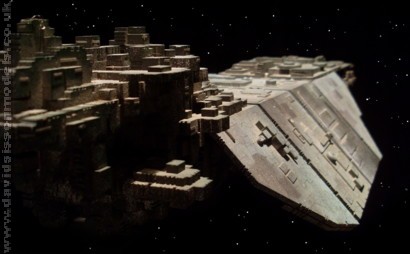 |
We worked
from an initial series of storyboard type concept
sketches that Steve Begg drew up, and as long as we kept
the basic outline shape we were free to block out the
ships and detail as we saw fit. I made the Rhino, Fin, and one that was fabricated with both horizontal and vertical panels, and Steven Woodcock made the others. |
| Basically, we saw them as giant floating alien cities so rather than using the more obvious plastic kit detailing, we came up with a system which used off-cuts of 3,6, and 8mm Perspex pieces. These were cut en-mass into irregular but right-angled shapes which were then put partly through the bandsaw to nibble off corners and cut slots which when glued together in a modular perpendicular fashion gave the impression of tower blocks of detail. |
| This worked really well when contrasted against other areas of the ships which were actually quite sleek. Steven and I would spend a while making boxes full of these components and when we had enough would dip into the box and detail as needed. By treating it as an assembly line worked well too and made us more efficient. It was a quick way to make something which would have looked very different if fabricated from kit parts. It also used up all the odd shaped Perspex off cuts. | 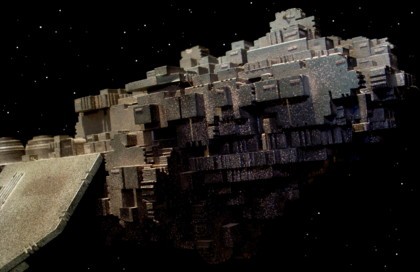 |
| In addition to making the ships, we also came up with the painted finish too. On completion I would spray the whole ship matt black, then mix up a number of different shades of metallic / pearlescent greens and blues, and then proceeded to airbrush them in varying stages of opacity until I achieved a layered finish which in places still retained the black undercoat. When lit on the stage they sort of came out of nowhere against the darkness of space. |
|
|
| This
particular piece was one of my favourites as it was so
original and different to any of the other Terrahawk
models. I used all sorts of different plastic
textured sheet material, including shower screens, ripple
sheet plastic, and other textured fabrics. I also
detailed with strands of hot melt glue which gave a real
alien feel. I was all the time trying to emulate the detail which is visible on the derelict ship from Alien which I found very inspiring (and still do). ........................................................................ Right: Rhino large-scale section |
 |
| The six spaceships
built by John and Steven were in fact replacements for a
previous set that were deemed to be unacceptable for the
series. As they both explained (at the Terrahawks
convention in 2013) the SFX director of the time, Ian
Scoones, told them to closely copy Steven Begg's basic
sketches with little modification or improvement. Then
these more simple shapes were covered in a shimmering
reflective material that would give the illusion of the
vessels appearing to almost materialise, or alter form,
in front of camera as they approached from deep space. (One of these designs can be seen in the group shot on their interview page, model is far left). These designs were eventually ditched in favour of John and Stevens new models, however the central docking ring with Zelda's hovering command ship remained, and the finished model closely resembles the design sketches. |
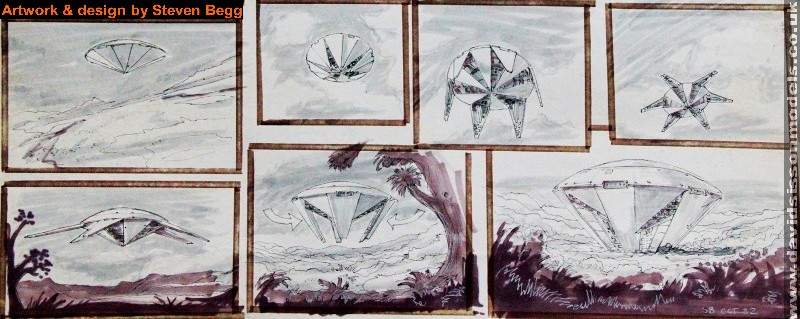 |
| Above: Steven Begg artwork for Zelda's central control vessel.......... Below: Peter Bohanna details two different scale models of the ship. |
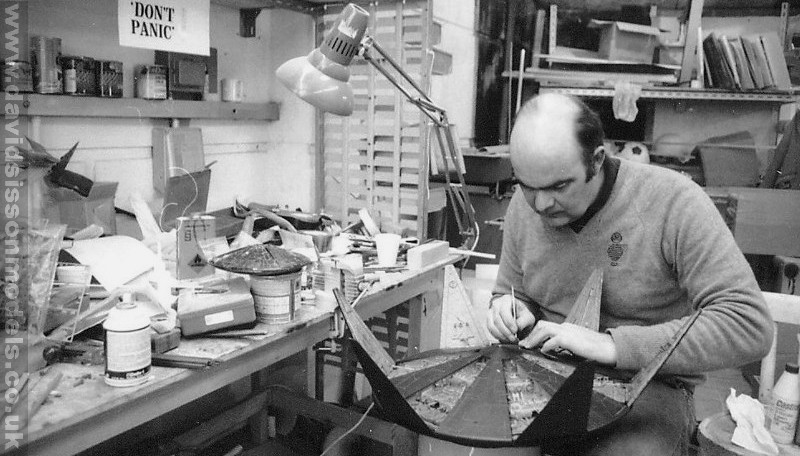 |
| Below: Filming a low-angle shot of the model for episode two. |
 |
Studio
photographs by Anderson Burr Pictures Ltd.
Rhino
Explosion shot courtesy of Fanderson
My thanks to Steven Woodcock for his photograph
My thanks also
to Steven Begg for fishing out his designs and 'Aliens'
model shot.
Thanks also to
Bob Bailey for the loan of the existing spaceship model.
'Terrahawks'
is copyright by Christopher Burr
No infringement of copyright is intended - non-profit fan
interest site only.
'Terrahawks' is a Gerry Anderson and Christopher
Burr Production.
| Back to TERRAHAWKS
Selection Article David Sisson 2013 |